1 min read
Tue 13 Feb 2024
Writing
Membership systems and electoral strategy
Project background
Elections as a moment of political terraforming
At Common Knowledge, our particular interest is in bottom up (or grassroots) rather than top down politics. When the bread and butter of conventional politics is oriented towards political elites, whether by lobbying and policy advocacy or by installing new political elites through elections, we instead emphasise collective self-organising as key to radical social change.
But while elections are not our key focus, electoral cycles will always be a crucial time in politics.
We see elections as a moment or tactic in the wider field of social change. The process and outcome of an election shapes the terrain on which movements operate. They can either operate on highly unfavourable terrain, where their effort needs to go into firefighting and even sheer survival, or they can operate on more favourable terrain, where some needs are met and other questions can be addressed. Elections to some extent terraform this terrain.
Despite a general (and understandable!) trend of apathy towards formal politics, it is also true engagement always rises significantly during an election year. This means a larger audience, with more attention being paid than usual. While organisers often have an expanded theory of politics, elections are one of the main times when “politics happens” for a lot of people, i.e. when social needs, possibilities and political decisions are collectively discussed and considered, especially for those who aren’t involved in other organised political activity.
These moments are a crucial opportunity for grassroots groups to build power, recruit new members, strengthen their collective leadership and push the Overton window towards their own agenda. In elections, groups can learn new skills, raise capability and capacity and become more coherent as a group. We have seen these skills are transferable to other organising contexts. This includes the basic mechanics and tactics of elections: to hold a strike, one needs to first win a ballot. Something like “get out the vote” drives are an important element of this.
Regardless of which party comes into power, we want to empower non-electoral actors within the movement ecology before, during and after the election, particularly those that operate at pivotal sites of struggle like universalising access to healthcare, homes and energy, or responding to the climate crisis.
Methodology and technology
Our goal is to use this moment as an opportunity to establish a set of practices and software, or ‘methodology and technology’ as our comrades at the Zetkin Foundation like to say, that will strengthen these organisations’ relational power and persist after the General Election cycle is over. In doing so, we will enable them to focus on the quality of the relationships between members and ultimately facilitate more people to take up progressive collective action in the long-term.
Focusing on long-term goals
As The Social Practice Europe identified in their Organising at Scale Briefing Note, in order to build power through elections, it is crucial to prioritise medium and long-term goals like leadership development, building relationships with members and having a plan for those people after the election. Another reference point is the book Prisms of the People , which gives really clear analysis and strategic recommendations from the US, where civil society and particularly community organising-based organisations are regularly involved in electoral work. Elections are a moment of potential crystallisation that builds power over the longer term.
To put this in a different way: our goal with this project is to help facilitate election mobilisation without the accompanying demobilisation.
Approach
Our strategy with this project is to help grassroots organisations to build a base of people concerned about progressive issues in the marginal seats that political parties will be paying attention to. We have been identifying ways to improve these organisations’ digital organising systems to enable them to build deeper relationships with their members. The goal is to streamline their systems in order that they can spend more time on organising and strategy and less time battling with their digital tools.
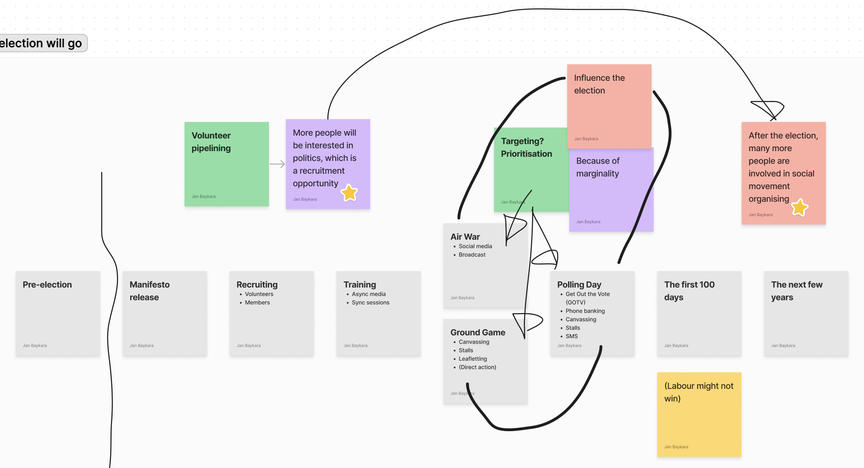
Our approach to this work has four angles:
- Co-designing digital solutions in partnership with a cohort of grassroots organisations
- Prototyping a series of digital interventions to test out our hypotheses
- Coordinating efforts with other actors working towards more radical electoral outcomes
- Training organisers how to better use the tools that they have already
Co-designing
Over the last few months, we’ve been working closely with organisers from Green New Deal Rising , POMOC and MedAct . We’ve run a series of workshops to understand their membership systems and electoral strategies. Through these workshops, they’ve helped us identify which interventions we could make into their digital systems. By working with these organisations directly, we can ground our ideas in what will concretely improve their systems, while also looking for ways to generalise these interventions for wider use and impact.
Each organisation has slightly different levels of maturity when it comes to their technical infrastructure, organising culture and organisational structure. Working together in a cohort like this means that the organisers are able to learn together and help each other. We see our role as holding space for projects like this to reflect on political, organisational and technical strategy from a movement ecology lens.
Prototyping
To counter this highly specific consultancy work, we have also been prototyping more general interventions that will be useful to a broad range of progressive organisations in improving their membership lifecycles, from members joining to deepening engagement to updating their circumstances.
Given the costs and challenges of designing, building and maintaining technical infrastructure , our co-op is always interested in re-use by multiple actors at movement scale. Our key aim here is to produce concrete value for as many organisations as possible, even if they are minor interventions, by recognising needs, wants and ambitions that are shared and can be similarly facilitated by tooling.
We know that organisations won’t want to replace their systems this close to an election, but rather add to or improve what they have already. Therefore, our focus is on complementing what is out there already rather than duplicating or replacing it.
To do this, we’ve created some lightweight and low risk but high impact interventions that concretely improve the workflows of organisers. This emphasis on research-through-prototyping means that we can test out our ideas quickly in the real world, rather than getting stuck in ideation and strategy. We see prototyping as a tool for asking more useful questions.
We have also done ad hoc infrastructural work in response to direct requests from longtime collaborators like Just Treatment , London Renters Union and the Centre for Progressive Change , with a similar emphasis: something concrete that works, but also something to learn from.
For example, we worked with Just Treatment to build a Constituency Updater form that enriches their Action Network, in response to their need to identify supporters’ constituencies ahead of the general election and in the knowledge of changing constituency boundaries and outdated location data. We’ve since spoken with other organisers in the same situation and adapted the tool to be re-usable with just a little bit of configuration. Get in touch if you or an organisation you know would like to set this up for your members list!

Coordinating
In early interviews for this work, we recognised that building relationships with prospective parliamentary candidates was something that many movement actors had identified as a need. In collaboration, Movement Research Unit , supported by NEON , worked with their brilliant network of researchers to build FutureLabourMPs.com . The tool lists (at the moment) Labour parliamentary candidates, their contact details and positions on a variety of issues.
We have also been coordinating with organisations like MySociety , looking for ways that we can cooperate with them and build upon their work with The Climate Coalition on the Local Intelligence Hub .
Training
So far, we have been doing ad hoc training as part of our research and prototyping work. Early on in this project, we did a survey of NEON’s mailing list to understand the most common membership management systems. Of the organisations who responded, the most popular CRMs are Mailchimp (29%), Action Network (22%), Airtable (11%), Google Sheets (9%). Nation Builder did not feature in the survey, although we know that large organisations like ACORN and Momentum both use it, as well as mainstream parties like the Conservatives, Plaid Cymru and Reform UK. We got early feedback from NEON’s network that the term ‘CRM’ (customer relationship management) was confusing to them and adapted the survey, a learning for future outreach in this area of infrastructure work.
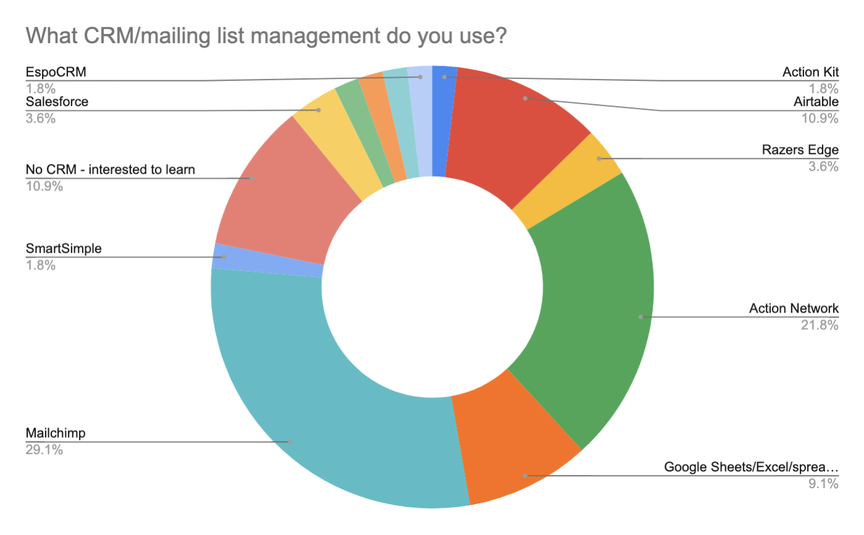
We asked them about their experience using these systems, with a view towards offering a more comprehensive training on digital membership management next month. If you’re interested in attending this, please get in touch.
Discovery
We began this work with a tightly scoped Discovery process. We were very conscious that we wanted to avoid getting stuck in a speculative research phase. We also wanted to find a balance between learning new insights and building upon what we already know from 6 years of doing this work as Common Knowledge. We used Will Myddleton’s very useful guides as a reference for shaping this discovery process. As he puts it, “discovery isn’t about exploring a problem, it’s about making a decision about what to do next.”
Our broad aims for this Discovery work were to:
- Understand our collaborators’ electoral strategies, membership systems, data maturity, capacity, key constituencies, election issues and goal metrics.
- Identify which political geography and data layers would be useful to enrich member data with, and how to do this data augmentation on a technical level.
- Determine which issues could be solved by better training on existing systems, both for the immediate group and the wider movement.
Workshops with our collaborators
Assessing shared needs
We ran two online workshops with the cohort. This was an opportunity for them to share notes about what they had planned for the election as well as their puzzles and challenges. They had a mixture of constituency-specific campaigning, deep organising, attention-capturing direct actions and media interventions planned for the election period. We did some brainstorming to identify shared needs and generate new ideas for technical interventions that could support their strategies.
Geographic distribution of members
As we suspected, a common puzzle shared by organisers is the geographic distribution of their member lists—where are they?—and potential supporters too. Even for organisations with good location data for their lists, density by 2024 constituency is uncertain. Demographic data from the 2021 UK government census has been useful for targeting outreach, but this is a tedious task.
Coalition partner mapping
Issue-based campaigns by nature work in coalitions and the campaigns in our cohort expressed a desire to coordinate at a more granular level. “Collaborator mapping” is another dimension of seeing the full picture, next to mapping members themselves, and thinking about campaigning ontology helps us distinguish geographical mapping from ‘mapping’ more broadly as a tool for strategy . For example, how can we support campaigns to power map their coalitions, and to what degree does this ask for a software, data or training intervention? How can we make the work of strategy-shaping more accessible and impactful?
Data silos
Another major pain point, which is a familiar pattern in our work, is that organisations’ data is often siloed into separate systems. There isn’t an easy way to get an overview of everything and understand how it adds up. In general, it felt like organisers are not able to get a full picture of their membership and have to make strategic decisions based on hunches rather than data.
We captured some uncertainties that organisers have when developing strategy:
- Where are our members, geographically?
- How can we reach potential members?
- How can members help if they’re not in a target constituency?
- How to actually get people to do the work we want to do?
- How do we get the numbers that we need via recruitment?
Narrowing down potential prototypes
In the second workshop, we demonstrated some of the prototypes we’d been working to check their potential usefulness. We proposed a range of different ideas for interventions and asked them to map them onto an impact / effort matrix in order to identify the shared high priority topics.
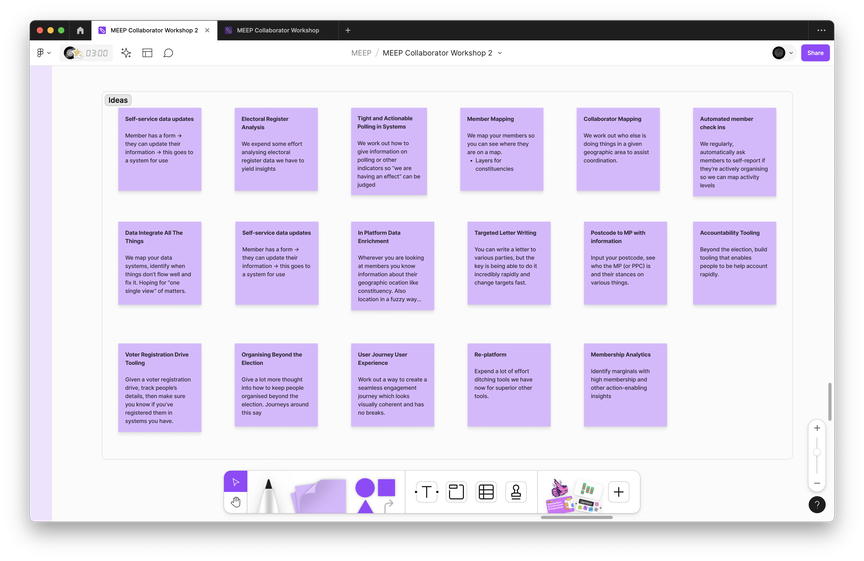
The idea of this process was to boil down the needs to a set of “alpha” ideas. In software development, the alpha stage is the first prototype release of a piece of software, followed by the beta and major release . Here our five key alpha ideas are:
- Data Integrate All The Things: Data systems mapping to identify when things don’t flow well and fix it.
- In Platform Data Enrichment: Integrating (fuzzy) information about members’ geographic locations/constituencies into existing membership management platforms.
- Automated Member Check-ins: Regularly, automatically ask members to self-report if they’re actively organising so we can map activity levels.
- Collaborator Mapping: Mapping which other organisations are active in a given geographic area to assist coordination.
- User Journey UX: A seamless engagement journey which looks visually coherent and has no breaks.
Prototyping
We have dedicated some of this funding towards improving Mapped , which we began in February 2023 with the support of the Civic Power Fund . Mapped is a lightweight web tool for organisers to locate their people by constituency and much more, that replaces manual processes for geocoding membership lists , based on feedback from organisers we have built relationships with. You can either upload a spreadsheet of your membership list and it will enrich it with location-specific columns like constituency, ward, Primary Care Trust and NHS Health Authority. Or you can search by postcode to see how the changing constituency boundaries will impact a particular location.
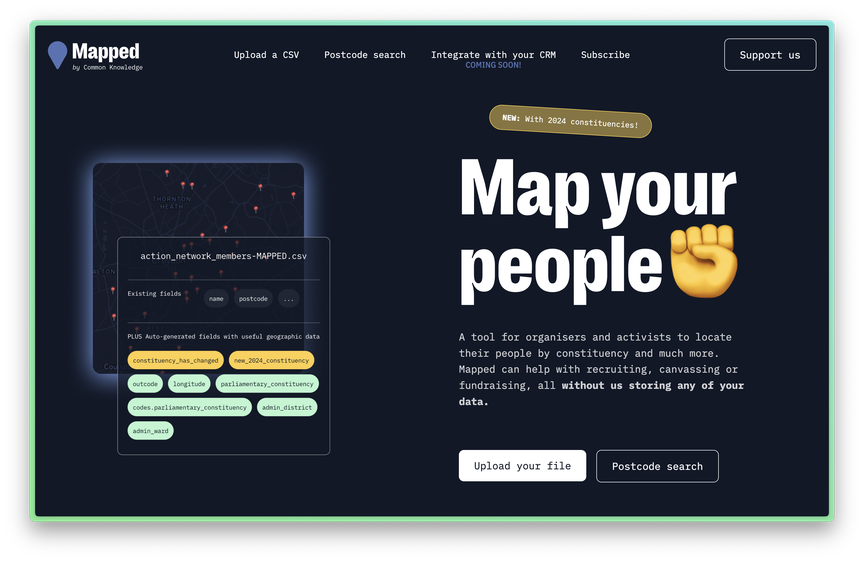
Our whole team was together in person for a week in early December, so we held a hackathon to improve the tool. It was really fun to work all together on this.

Over one day, we:
- Designed an initial version of the dashboard analytics screen, where people can search by postcode and see the location overlaid with useful electoral data.
- Built a plug-n-play data platform that allows organisers to configure different data sources.
- Prototyped an Action Network service that updates membership lists with the new constituencies.
- Streamlined our technical workflow between Webflow, Devlink and GitHub to improve the collaboration workflow between designers and developers.

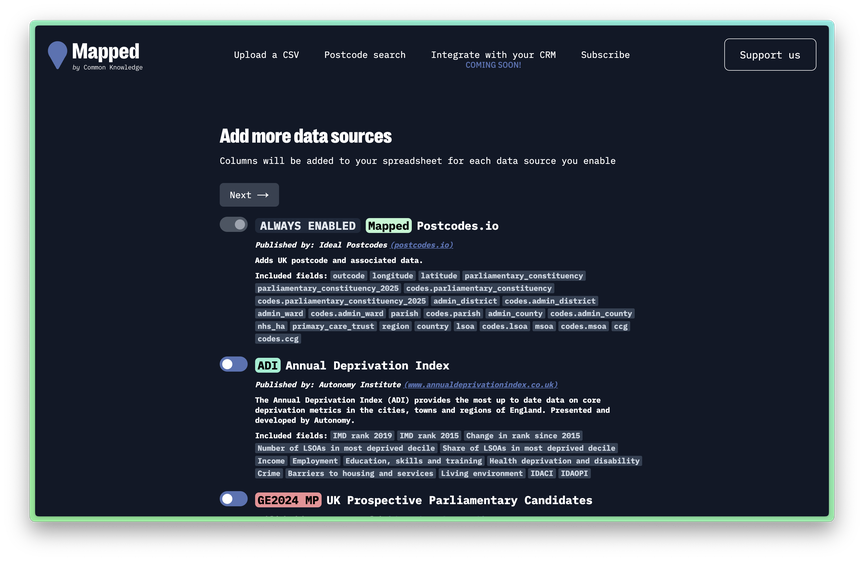
Reflections: can we liberate campaign data from their databases?
Member databases are a critical resource for mass campaigns. At their simplest level, a list of email addresses implies a signup process and, in return, broadcast communications — the mainstay of many such campaigns. Right now, membership databases sit at the centre of a campaign’s technical stack, alone, without other critical data sources that together would enable strategy and tactics of other kinds beyond signup forms and broadcast communications.
We can think about this flow of data from two angles: into the database and back out of it. The “data in” story is important because it enables member-oriented campaigning. Of the alpha ideas above, the first three improve the quality of incoming data by asking members to self-report activity, integrating the data sources organisations have already and augmenting their database with more data.
We have begun developing a series of tools addressing this area of needs already: our Join Flow (currently used by Nurses United , the Green Party and Progressive International and soon by London Renters Union and The Architecture Lobby ), Member Self-Update Dashboard, Constituency Updater and Spreadsheet Enricher (as seen in Mapped ). All of these tools are ‘database-agnostic’: they plug into the systems you have, recognising that organisational infrastructures are deeply embedded in organisers’ workflows.
But what about the “data out” story?
From our research, we’ve learned that at the moment this essentially doesn’t happen. Member data, once collected, mostly stays there for the majority of campaigns. An important exception is the sharing of sub-lists with branches and local organisers, although this is technically difficult with tools like Airtable, especially since they removed the ability to sync paid bases to free-tier users (as part of the inherent profiteering of venture capital-backed infrastructure!)
This was a need that James Darling talked about in his membership prototype . The main use that member data is put to is sending broadcast emails. This has a role in any successful organisation, even simply for fundraising to keep the lights on. There are many people who do great work around this. However, it is not organising and can only be an invitation to it.
We know that campaigners have many insights they wish to glean out of their member lists. On the most basic level, they want to know where their members are located geographically. But they also want to know specific information based on demographic and historical election data, or contextual information to overlay their membership lists, like what their partner organisations are up to.
We’re interested in focusing on building some “data out” tools that piece together subtle, high-dimensional pictures out of multiple information sources, spark creative thoughts, and then support their iteration and development through interaction. One analogous way of thinking about this is: information to intelligence .
We want “data out” to mean enabling the widest possible number of people to be involved in the transformative work of organising. This is often why people voluntarily put their data into these systems in the first place.
This would be useful to both organisers as they plan campaigns, but also decentralised, semi-formal organiser/members on the ground. We think that it is so important for members to be able to access campaign information and organise themselves semi-autonomously in service of wider campaign aims.
One great example of this was Becky Bond’s 2018 Beto O’Rourke campaign map , which enabled supporters to directly access campaign voter contact data. We explored a similar concept when we built the My Campaign Map tool for the 2019 general election.
There is potentially a third category too: would-be members, or in other words, concerned constituents or allies — people whose concerns are probably represented with the campaign, and whose actions may start independently or “non-politically”, but could organically come into informal and then formal alignment with a campaign through supporting and joining.
One example is the Don’t Pay 2022 campaign map, which let the whole world know how many people were going to cancel our fuel bills, reassuring people, building engagement in the campaign, and scaring the crap out of energy companies in the process, provoking real social change. Campaign data, when composed, can be fantastic framing, recruiting, agitation and propaganda.
Next steps
Next week, we’re running some one-on-one calls with cohort members to show them some prototypes, gather feedback and make decisions about where to go from here. We’ll also be building out a backlog of tasks to start making this vision into a reality.
In March and April, we’ll be running some training sessions and a public show-and-tell to share what we’ve learned from this project. Get in touch if you’d like to join.